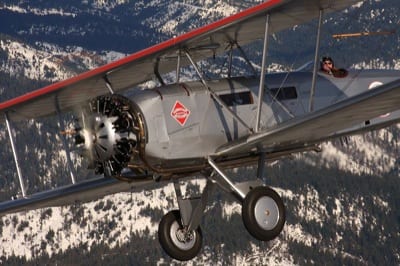By ADDISON PEMBERTON, For General Aviation News
What’s it like to fly a 1928 Boeing 40C?
Since restoring this vintage plane, I’ve flown it for more than 130 hours, including a trip from New York to San Francisco in September 2008.

The aircraft is very sturdy and gives one the feeling of great comfort and safety. It is big — 13 feet high, 33 feet long, with a 44-1/2 foot wing span.
It has very heavy controls, but offers reasonable response to control inputs. I would compare aileron and elevator flight control force to three times that of a stock military model 75 Stearman with the weight feel of a North American AT-6. The rudder controls forces can be alarming at times with more than 50 pounds of peddle force required to counteract adverse yaw from a depressed aileron in turbulence.
Pitch and yaw stability is excellent, but roll stability in turbulent air is poor, requiring constant aileron and rudder input to keep the airplane on track.
In rough air, I am careful to call up the cabin and broadcast cockpit housekeeping tasks, such as map folding, to keep from alarming my passengers. Rough air flight can be exhausting for the pilot after a few short hours, while smooth air flight is a delight.
The cockpit is very comfortable with very little wind. The ergonomics of all cockpit controls is excellent.
Takeoff acceleration is impressive and takeoff runs at maximum power can be as short as five to seven seconds; 2,000 rpm yields better that 1,000 fpm even at high density altitude airports thanks to the Pratt and Whitney 1340 600-hp supercharged engine and constant speed propeller.
Cruise at 3,000 feet and 1,800 rpm yields 115 mph indicated at 28 gph fuel burn. Fuel capacity is 140 gallons in three wing selectable tanks.
Runway handling is excellent and the aircraft tracks well with minimum pilot inputs. Touchdowns are often imperceptible thanks to the big wheels and 11 inches of oleo travel. We incorporated a locking tail assembly from a Twin Beech 18 that works very well. The airplane in its original configuration used a tail skid, which was very stabilizing.
Visibility on final is very poor, requiring a “peek a boo” slip to keep the runway in sight. This slip is carried within a few feet of touchdown on narrow runways to maintain runway discipline. Tail low transport landings work well on hard surfaces and three-point landings are used on grass runways. Three-point landing restricts visibility and requires practice to accomplish them safely.
The narrow cabin has four staggered seats to improve shoulder room, but offers ample leg room. The original telephone system allows communications with the pilot. Cabin noise is high but bearable. Headsets are used for long trips and make the flight experience pleasant. Passengers like the Pullman Car-like appointments and smooth “gliding along the countryside” ride.
All in all, the Boeing 40C is a wonderful machine — and real tribute to the aircraft design pioneers of the 1920s.
For more information: Home.comcast.net/~Biplane0.
